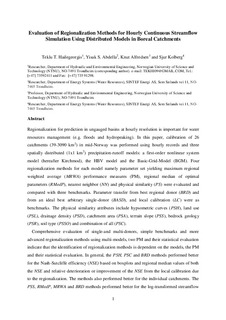| dc.contributor.author | Hailegeorgis, Teklu Tesfaye | |
| dc.contributor.author | Abdella, Yisak Sultan | |
| dc.contributor.author | Alfredsen, Knut | |
| dc.contributor.author | Kolberg, Sjur | |
| dc.date.accessioned | 2018-01-26T15:03:03Z | |
| dc.date.available | 2018-01-26T15:03:03Z | |
| dc.date.created | 2015-04-18T08:28:59Z | |
| dc.date.issued | 2015 | |
| dc.identifier.citation | Journal of hydrologic engineering. 2015, 20 (11), . | nb_NO |
| dc.identifier.issn | 1084-0699 | |
| dc.identifier.uri | http://hdl.handle.net/11250/2479997 | |
| dc.description.abstract | Regionalization for prediction in ungauged basins at hourly resolution is important for water resources management (e.g. floods and hydropeaking). In this paper, calibration of 26 catchments (39-3090 km2 ) in mid-Norway was performed using hourly records and three spatially distributed (1x1 km2 ) precipitation-runoff models: a first-order nonlinear system model (hereafter Kirchmod), the HBV model and the Basic-Grid-Model (BGM). Four regionalization methods for each model namely parameter set yielding maximum regional weighted average (MRWA) performance measures (PM), regional median of optimal parameters (RMedP), nearest neighbor (NN) and physical similarity (PS) were evaluated and compared with three benchmarks. Parameter transfer from best regional donor (BRD) and from an ideal best arbitrary single-donor (BASD), and local calibration (LC) were as benchmarks. The physical similarity attributes include hypsometric curves (PSH), land use (PSL), drainage density (PSD), catchment area (PSA), terrain slope (PSS), bedrock geology (PSR), soil type (PSSO) and combination of all (PSC). Comprehensive evaluation of single-and multi-donors, simple benchmarks and more advanced regionalization methods using multi-models, two PM and their statistical evaluation indicate that the identification of regionalization methods is dependent on the models, the PM and their statistical evaluation. In general, the PSH, PSC and BRD methods performed better for the Nash-Sutcliffe efficiency (NSE) based on boxplots and regional median values of both the NSE and relative deterioration or improvement of the NSE from the local calibration due to the regionalization. The methods also performed better for the individual catchments. The PSS, RMedP, MRWA and BRD methods performed better for the log-transformed streamflow 2 (NSEln) based on the same evaluation criteria. Similar performance to the more advanced regionalization methods of transfer of homogeneous parameter sets across the whole region from the BRD for both NSE and NSEln indicate the potential of the simple regionalization approach for predicting runoff response in the region. | nb_NO |
| dc.language.iso | eng | nb_NO |
| dc.publisher | American Society of Civil Engineers | nb_NO |
| dc.title | Evaluation of Regionalization Methods for Hourly Continuous Streamflow Simulation Using Distributed Models in Boreal Catchments | nb_NO |
| dc.type | Journal article | nb_NO |
| dc.type | Peer reviewed | nb_NO |
| dc.description.version | acceptedVersion | nb_NO |
| dc.source.pagenumber | 20 | nb_NO |
| dc.source.volume | 20 | nb_NO |
| dc.source.journal | Journal of hydrologic engineering | nb_NO |
| dc.source.issue | 11 | nb_NO |
| dc.identifier.doi | 10.1061/(ASCE)HE.1943-5584.0001218 | |
| dc.identifier.cristin | 1237919 | |
| dc.relation.project | Norges forskningsråd: 193818 | nb_NO |
| dc.description.localcode | © 2015. This is the authors' accepted and refereed manuscript to the article. The final authenticated version is available online at: https://ascelibrary.org/doi/10.1061/%28ASCE%29HE.1943-5584.0001218 | nb_NO |
| cristin.unitcode | 194,64,91,0 | |
| cristin.unitname | Institutt for bygg- og miljøteknikk | |
| cristin.ispublished | true | |
| cristin.fulltext | postprint | |
| cristin.qualitycode | 2 | |
